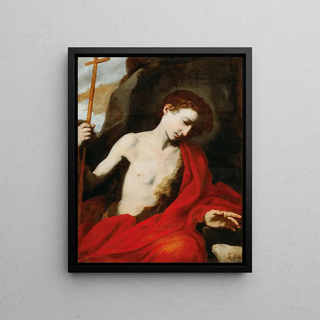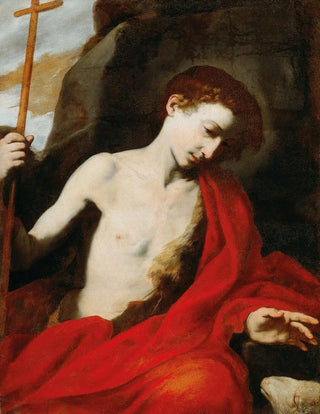Art print | Saint Jean-Baptiste - Jusepe de Ribera Source: Reproduction | Saint Jean-Baptiste - Jusepe de Ribera


View from behind

Frame (optional)
Saint John the Baptist - Jusepe de Ribera – Captivating Introduction
The "Saint John the Baptist" canvas by Jusepe de Ribera is an iconic artwork that embodies the spiritual depth and technical virtuosity of the Spanish master of the 17th century. Created within the baroque context, this painting does more than depict a saint; it immerses the viewer in an intense visual experience where light and shadow engage in a fascinating dance. The figure of Saint John the Baptist, with his penetrating gaze and expression filled with gravity, seems to transcend the frame of the canvas and invites the observer to an inner reflection. This masterpiece, through its evocative power, continues to captivate art enthusiasts and history lovers alike.
Style and uniqueness of the work
Ribera, nicknamed the "Spagnoleto," stands out for his unique style that combines raw realism with poignant expressiveness. In "Saint John the Baptist," the artist employs striking contrasts between light and darkness, a technique known as chiaroscuro, which emphasizes the strength of the saint's features. The muscular body of John the Baptist, both human and divine, is modeled with precision that reflects meticulous observation of nature. The color palette, dominated by earthy tones and shades of deep red, enhances the dramatic dimension of the scene. Every detail, from the leather of the belt to the texture of the skin, is rendered with such intensity that it almost feels tangible, creating an intimate connection between the artwork and the viewer.
The artist and his influence
Jusepe de Ribera, born in Spain but having spent much of his life in Naples, managed to incorporate influences from Italian painting while developing a distinctive identity. His work is marked by a deep commitment to depicting religious themes, but also by a fascination with the human condition in all its complexity. Ribera was a pioneer in the way he approached the figure of the saint, making it more accessible and human, far from classical ideals. His impact on subsequent generations of artists is undeniable. Painters like Francisco de Goya and even contemporary artists recognize the influence of his work.

Matte finish

View from behind

Frame (optional)
Saint John the Baptist - Jusepe de Ribera – Captivating Introduction
The "Saint John the Baptist" canvas by Jusepe de Ribera is an iconic artwork that embodies the spiritual depth and technical virtuosity of the Spanish master of the 17th century. Created within the baroque context, this painting does more than depict a saint; it immerses the viewer in an intense visual experience where light and shadow engage in a fascinating dance. The figure of Saint John the Baptist, with his penetrating gaze and expression filled with gravity, seems to transcend the frame of the canvas and invites the observer to an inner reflection. This masterpiece, through its evocative power, continues to captivate art enthusiasts and history lovers alike.
Style and uniqueness of the work
Ribera, nicknamed the "Spagnoleto," stands out for his unique style that combines raw realism with poignant expressiveness. In "Saint John the Baptist," the artist employs striking contrasts between light and darkness, a technique known as chiaroscuro, which emphasizes the strength of the saint's features. The muscular body of John the Baptist, both human and divine, is modeled with precision that reflects meticulous observation of nature. The color palette, dominated by earthy tones and shades of deep red, enhances the dramatic dimension of the scene. Every detail, from the leather of the belt to the texture of the skin, is rendered with such intensity that it almost feels tangible, creating an intimate connection between the artwork and the viewer.
The artist and his influence
Jusepe de Ribera, born in Spain but having spent much of his life in Naples, managed to incorporate influences from Italian painting while developing a distinctive identity. His work is marked by a deep commitment to depicting religious themes, but also by a fascination with the human condition in all its complexity. Ribera was a pioneer in the way he approached the figure of the saint, making it more accessible and human, far from classical ideals. His impact on subsequent generations of artists is undeniable. Painters like Francisco de Goya and even contemporary artists recognize the influence of his work.






